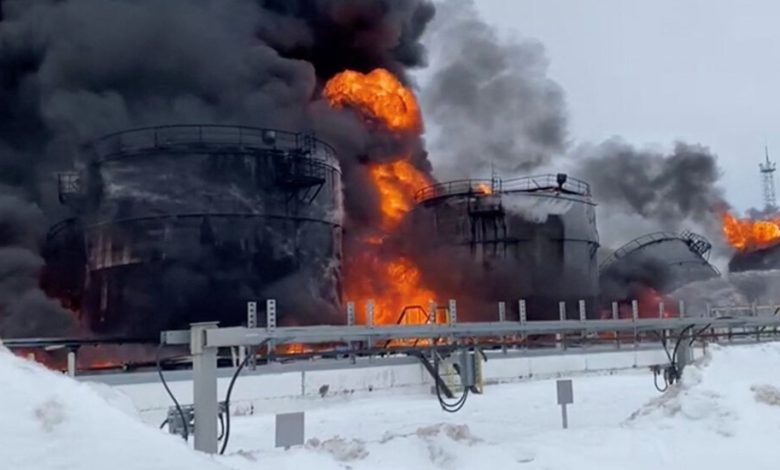Ukraine Targets Russian Oil Plants, Aiming to Disrupt Military Operations

Ukraine hit an oil depot in Russia in a drone attack on Friday, officials on both sides said, the latest in a series of recent assaults targeting Russian oil facilities as Kyiv increasingly seeks to strike critical infrastructure behind Russian lines.
Alexander Bogomaz, the governor of the Russian region of Bryansk, which borders Ukraine, said oil tanks in the town of Klintsy had caught fire after a drone dropped munitions on the depot. The drone, he added, was brought down by electronic jamming. A Ukrainian intelligence official, speaking on condition of anonymity to discuss sensitive military matters, said Ukraine was behind the assault.
Friday’s attack was the fourth on a Russian oil facility in the past three weeks, in what experts say is an effort by Ukraine to deliver setbacks to Russia’s military capabilities by targeting the facilities that supply fuel to tanks, fighter jets and other critical military equipment.
“Strikes on oil depots and oil storage facilities disrupt logistics routes and slow down combat operations,” said Olena Lapenko, an energy security expert at DiXi Group, a Ukrainian think tank. “Disruption of these supplies, which are like blood for the human body, is part of a wider strategy to counter Russia on the battlefield.”
These attacks are unlikely to have a substantive impact on the overall posture of the fighting, in which Russia has shifted to the offensive the past several months. But they remain important for Ukraine, which has looked for ways to inflict damage away from the largely deadlocked front line. Without enough weapons and troops to regain the initiative on the ground, Kyiv has increasingly turned to guerrilla tactics to disrupt Russian operations, including sabotage activities against railway infrastructure and ammunition depots.
Oleksandr Kamyshin, Ukraine’s minister for strategic industries, said on Thursday that an “asymmetrical war” was underway. He claimed responsibility for an attack that targeted an oil storage facility in St. Petersburg on Thursday, which he said involved a domestically produced drone that flew 1,250 kilometers, or about 775 miles.
“I’m sure we will see more and more things happening this year,” Mr. Kamyshin said during a panel discussion at the World Economic Forum in Davos, Switzerland.
While the St. Petersburg attack did not appear to cause serious damage, images of the Klintsy oil depot showed an extensive fire raging among several tanks. The Russian state news agency TASS said the fire covered an area of around 1,000 square meters, or about 10,700 square feet, and that four gasoline tanks were burning.
Mr. Bogomaz, the Russian governor, said in a social media post that more than 140 firefighters were trying to extinguish the blaze. He released a video showing them spraying water on blackened oil tanks from which huge plumes of black smoke were rising.
Power infrastructure has been a major theater in the war. Last winter, Russia pummeled Ukraine’s energy facilities with drones and missiles, plunging Ukrainians into cold and darkness, in what was seen as an attempt by Moscow to turn winter into a weapon and demoralize the population. Ukraine managed to survive the assaults because of Western-supplied air defense systems and round-the-clock work by engineers to repair vital equipment.
Ukraine, on a smaller scale, has targeted Russian oil and gas infrastructure since the beginning of the conflict. But the recent spate of attacks may indicate that energy infrastructure has now become a critical objective for Kyiv.
Two other drone attacks, on Dec. 29 and Jan. 9, resulted in fires at a refinery in Russia’s southwestern Krasnodar region and at a fuel facility in Oryol, a town not far from Klintsy. On both occasions, the Ukrainian military claimed responsibility in Ukrainian news outlets.
By targeting oil facilities, Ukraine not only is trying to disrupt supplies to the Russian military, it is also aiming at assets that generate substantial revenue to support Moscow’s war effort.
Ms. Lapenko, the energy security expert, said Moscow had earned more than $400 billion from oil exports since the war began. Russia has partly managed to circumvent international sanctions by using alternative financial services and even investing in a “shadow” fleet to export its oil clandestinely.
“We see that the imposed sanctions do not work effectively enough, so the aggressor still receives enough funds to wage war,” Ms. Lapenko said.
In addition to the strikes on oil facilities, Kyiv has launched at least four attacks against electricity substations since September, some of which have led to power cuts for civilians, according to the Russian local authorities. The Ukrainian army asserts that it attacks only power facilities directly linked to Russia’s military campaign.
Several Ukrainian officials had said in recent months that Ukraine would respond to Moscow’s attacks on critical infrastructure.
“Let them start. They will also receive an answer,” Kyrylo Budanov, the head of Ukraine’s military intelligence, told The Economist magazine in September, adding that his services were working on a limited deterrence and retaliation campaign.
Daria Mitiuk contributed reporting.



